Piezoelectric Enhancement of Piezoceramic Nanoparticle-Doped PVDF/PCL Core-Sheath Fibers
Abstract
1. Introduction
2. Materials and Methods
2.1. Materials
2.2. Fabrication of Core-Sheath Fibers Doped with Nanoparticles
2.3. Characterization
3. Results and Discussion
3.1. Implementation of Electrospinning Fibers
3.2. Morphology of Electrospun Core-Sheath Fibers
3.3. Mechanical Properties
3.4. Structure Characterization
3.5. Piezoelectric Properties of Nanofibrous Films
4. Conclusions
Author Contributions
Funding
Institutional Review Board Statement
Informed Consent Statement
Data Availability Statement
Conflicts of Interest
References
- Wu, H.; Huang, Y.; Xu, F.; Duan, Y.; Yin, Z. Energy Harvesters for Wearable and Stretchable Electronics: From Flexibility to Stretchability. Adv. Mater. 2016, 28, 9881–9919. [Google Scholar] [CrossRef]
- Chun, J.; Ye, B.U.; Lee, J.W.; Choi, D.; Kang, C.-Y.; Kim, S.-W.; Wang, Z.L.; Baik, J.M. Boosted Output Performance of Triboelectric Nanogenerator via Electric Double Layer Effect. Nat. Commun. 2016, 7, 12985. [Google Scholar] [CrossRef]
- Luo, J.; Gao, W.; Wang, Z.L. The Triboelectric Nanogenerator as an Innovative Technology toward Intelligent Sports. Adv. Mater. 2021, 33, 2004178. [Google Scholar] [CrossRef]
- Roy, K.; Ghosh, S.K.; Sultana, A.; Garain, S.; Xie, M.; Bowen, C.R.; Henkel, K.; Schmeisser, D.; Mandal, D. A Self-Powered Wearable Pressure Sensor and Pyroelectric Breathing Sensor Based on Go Interfaced PVDF Nanofibers. ACS Appl. Nano Mater. 2019, 2, 2013–2025. [Google Scholar] [CrossRef]
- Maity, K.; Mandal, D. All-Organic High-Performance Piezoelectric Nanogenerator with Multilayer Assembled Electrospun Nanofiber Mats for Self-Powered Multifunctional Sensors. ACS Appl. Mater. Interfaces 2018, 10, 18257–18269. [Google Scholar] [CrossRef]
- Dubal, D.P.; Chodankar, N.R.; Kim, D.-H.; Gomez-Romero, P. Towards Flexible Solid-State Supercapacitors for Smart and Wearable Electronics. Chem. Soc. Rev. 2018, 47, 2065–2129. [Google Scholar] [CrossRef]
- Dong, K.; Deng, J.; Ding, W.; Wang, A.; Wang, P.; Cheng, C.; Wang, Y.; Jin, L.; Gu, B.; Sun, B.; et al. Versatile Core-Sheath Yarn for Sustainable Biomechanical Energy Harvesting and Real-Time Human-Interactive Sensing. Adv. Energy Mater. 2018, 8, 1801114. [Google Scholar] [CrossRef]
- Wei, M.; Ma, J.; Gao, T. Analysis on Pollution Prevention and Control of Waste Lead Battery Recycling Process. IOP Conf. Ser. Earth Environ. Sci. 2021, 651, 042008. [Google Scholar] [CrossRef]
- Carranza, G.; Do Nascimiento, M.; Fanals, J.; Febrer, J.; Valderrama, C. Life Cycle Assessment and Economic Analysis of the Electric Motorcycle in the City of Barcelona and the Impact on Air Pollution. Sci. Total Environ. 2022, 821, 153419. [Google Scholar] [CrossRef]
- Gao, S.; Liu, W.; Fu, D.; Liu, X. Research Progress on Recovering the Components of Spent Li-Ion Batteries. New Carbon Mater 2022, 37, 435–460. [Google Scholar] [CrossRef]
- Li, X.; An, Q.; Li, H.; Zhang, Y.; Chen, Z.; Teng, K.; Zhuang, J.; Zhang, Y.; Tong, W. A Porous Piezoelectric-Dielectric Flexible Energy Conversion Film for Electricity Generation from Multiple Sources. Chem. Phys. Lett. 2021, 767, 138357. [Google Scholar] [CrossRef]
- Xu, K.-F.; Zhang, Y.-W.; Niu, M.-Q.; Zang, J.; Xue, J.; Chen, L.-Q. An Improved Nonlinear Energy Sink with Electromagnetic Damping and Energy Harvesting. Int. J. Appl. Mech. 2022, 14, 2250055. [Google Scholar] [CrossRef]
- He, L.; Gu, X.; Wang, S.; Liu, X.; Hu, R.; Cheng, G. A Wind Energy Harvester Based on Piezoelectric Magnetic Compound. Phys. Status Solidi A Appl. Mater. 2022, 219, 2200227. [Google Scholar] [CrossRef]
- Ji, S.H.; Cho, Y.-S.; Yun, J.S. Wearable Core-Shell Piezoelectric Nanofiber Yarns for Body Movement Energy Harvesting. Nanomaterials 2019, 9, 555. [Google Scholar] [CrossRef]
- Chen, C.; Chen, L.; Wu, Z.; Guo, H.; Yu, W.; Du, Z.; Wang, Z.L. 3D Double-Faced Interlock Fabric Triboelectric Nanogenerator for Bio-Motion Energy Harvesting and as Self-Powered Stretching and 3D Tactile Sensors. Mater. Today 2020, 32, 84–93. [Google Scholar] [CrossRef]
- Hwang, G.-T.; Byun, M.; Jeong, C.K.; Lee, K.J. Flexible Piezoelectric Thin-Film Energy Harvesters and Nanosensors for Biomedical Applications. Adv. Health Mater. 2015, 4, 646–658. [Google Scholar] [CrossRef]
- Su, Y.; Li, Q.; Amagat, J.; Chen, M. 3D Spring-Based Piezoelectric Energy Generator. Nano Energy 2021, 90, 106578. [Google Scholar] [CrossRef]
- Sun, Y.; Liu, Y.; Zheng, Y.; Li, Z.; Fan, J.; Wang, L.; Liu, X.; Liu, J.; Shou, W. Enhanced Energy Harvesting Ability of ZnO/PAN Hybrid Piezoelectric Nanogenerators. ACS Appl. Mater. Interfaces 2020, 12, 54936–54945. [Google Scholar] [CrossRef]
- Muduli, S.P.; Veeralingam, S.; Badhulika, S. Interface Induced High-Performance Piezoelectric Nanogenerator Based on a Electrospun Three-Phase Composite Nanofiber for Wearable Applications. ACS Appl. Energy Mater. 2021, 4, 12593–12603. [Google Scholar] [CrossRef]
- Choi, E.S.; Kim, H.C.; Muthoka, R.M.; Panicker, P.S.; Agumba, D.O.; Kim, J. Aligned Cellulose Nanofiber Composite Made with Electrospinning of Cellulose Nanofiber-Polyvinyl Alcohol and Its Vibration Energy Harvesting. Compos. Sci. Technol. 2021, 209, 108795. [Google Scholar] [CrossRef]
- Chen, J.; Wang, Z.L. Reviving Vibration Energy Harvesting and Self-Powered Sensing by a Triboelectric Nanogenerator. Joule 2017, 1, 480–521. [Google Scholar] [CrossRef]
- Arica, T.A.; Isik, T.; Guner, T.; Horzum, N.; Demir, M.M. Advances in Electrospun Fiber-Based Flexible Nanogenerators for Wearable Applications. Macromol. Mater. Eng. 2021, 306, 2100143. [Google Scholar] [CrossRef]
- Wang, F.; Wang, Z.; Zhou, Y.; Fu, C.; Chen, F.; Zhang, Y.; Lu, H.; Wu, Y.; Chen, L.; Zheng, H. Windmill-Inspired Hybridized Triboelectric Nanogenerators Integrated with Power Management Circuit for Harvesting Wind and Acoustic Energy. Nano Energy 2020, 78, 105244. [Google Scholar] [CrossRef]
- Pu, X.; Liu, M.; Chen, X.; Sun, J.; Du, C.; Zhang, Y.; Zhai, J.; Hu, W.; Wang, Z.L. Ultrastretchable, Transparent Triboelectric Nanogenerator as Electronic Skin for Biomechanical Energy Harvesting and Tactile Sensing. Sci. Adv. 2017, 3, e1700015. [Google Scholar] [CrossRef]
- Lee, C.; Park, H.; Lee, J.-H. Recent Structure Development of Poly(Vinylidene Fluoride)-Based Piezoelectric Nanogenerator for Self-Powered Sensor. Actuators 2020, 9, 57. [Google Scholar] [CrossRef]
- Lai, Z.; Wang, S.; Zhu, L.; Zhang, G.; Wang, J.; Yang, K.; Yurchenko, D. A Hybrid Piezo-Dielectric Wind Energy Harvester for High-Performance Vortex-Induced Vibration Energy Harvesting. Mech. Syst. Signal Proc. 2021, 150, 107212. [Google Scholar] [CrossRef]
- Zaarour, B.; Zhu, L.; Huang, C.; Jin, X.; Alghafari, H.; Fang, J.; Lin, T. A Review on Piezoelectric Fibers and Nanowires for Energy Harvesting. J. Ind. Text. 2021, 51, 297–340. [Google Scholar] [CrossRef]
- Zheng, T.; Wu, J.; Xiao, D.; Zhu, J. Recent Development in Lead-Free Perovskite Piezoelectric Bulk Materials. Prog. Mater. Sci. 2018, 98, 552–624. [Google Scholar] [CrossRef]
- Ye, H.; Yang, F.; Pan, Z.; Hu, D.; Lv, X.; Chen, H.; Wang, F.; Wang, J.; Li, P.; Chen, J.; et al. Significantly Improvement of Comprehensive Energy Storage Performances with Lead-Free Relaxor Ferroelectric Ceramics for High-Temperature Capacitors Applications. Acta Mater. 2021, 203, 116484. [Google Scholar] [CrossRef]
- Alam, M.M.; Ghosh, S.K.; Sultana, A.; Mandal, D. An Effective Wind Energy Harvester of Paper Ash-Mediated Rapidly Synthesized ZnO Nanoparticle-Interfaced Electrospun PVDF Fiber. ACS Sustain. Chem. Eng. 2018, 6, 292–299. [Google Scholar] [CrossRef]
- Kalani, S.; Kohandani, R.; Bagherzadeh, R. Flexible Electrospun PVDF-BaTiO3 Hybrid Structure Pressure Sensor with Enhanced Efficiency. RSC Adv. 2020, 10, 35090–35098. [Google Scholar] [CrossRef]
- Khanbabaee, B.; Mehner, E.; Richter, C.; Hanzig, J.; Zschornak, M.; Pietsch, U.; Stoecker, H.; Leisegang, T.; Meyer, D.C.; Gorfman, S. Large Piezoelectricity in Electric-Field Modified Single Crystals of SrTiO3. Appl. Phys. Lett. 2016, 109, 222901. [Google Scholar] [CrossRef]
- Ponnamma, D.; Erturk, A.; Parangusan, H.; Deshmukh, K.; Ahamed, M.B.; Al Ali Al-Maadeed, M. Stretchable Quaternary Phasic PVDF-HFP Nanocomposite Films Containing Graphene-Titania-SrTiO3 for Mechanical Energy Harvesting. Emerg. Mater. 2018, 1, 55–65. [Google Scholar] [CrossRef]
- Yang, J.; Xu, F.; Jiang, H.; Wang, C.; Li, X.; Zhang, X.; Zhu, G. Piezoelectric Enhancement of an Electrospun AlN-Doped P(VDF-TrFE) Nanofiber Membrane. Mater. Chem. Front. 2021, 5, 5679–5688. [Google Scholar] [CrossRef]
- Kim, M.; Lee, S.; Kim, Y. Solvent-Controlled Crystalline Beta-Phase Formation in Electrospun P(VDF-TrFE) Fibers for Enhanced Piezoelectric Energy Harvesting. APL Mater. 2020, 8, 071109. [Google Scholar] [CrossRef]
- Yu, D.G.; Li, Q.; Song, W.; Xu, L.; Zhang, K.; Zhou, T. Advanced technique-based combination of innovation education and safety education in higher education. J. Chem. Educ. 2023, 100, 507–516. [Google Scholar] [CrossRef]
- Zhao, P.; Chen, W.; Feng, Z.; Liu, Y.; Liu, P.; Xie, Y.; Yu, D.-G. Electrospun Nanofibers for Periodontal Treatment: A Recent Progress. Int. J. Nanomed. 2022, 17, 4137–4162. [Google Scholar] [CrossRef]
- Zhou, Y.; Wang, M.; Yan, C.; Liu, H.; Yu, D.-G. Advances in the Application of Electrospun Drug-Loaded Nanofibers in the Treatment of Oral Ulcers. Biomolecules 2022, 12, 1254. [Google Scholar] [CrossRef]
- Suresh, S.; Becker, A.; Glasmacher, B. Impact of Apparatus Orientation and Gravity in Electrospinning—A Review of Empirical Evidence. Polymers 2020, 12, 2448. [Google Scholar] [CrossRef]
- Wang, M.; Hou, J.; Yu, D.G.; Li, S.; Zhu, J.; Chen, Z. Electrospun tri-layer nanodepots for sustained release of acyclovir. J. Alloys Compd. 2020, 846, 156471. [Google Scholar] [CrossRef]
- Wang, P.; Lv, H.; Cao, X.; Liu, Y.; Yu, D.-G. Recent Progress of the Preparation and Application of Electrospun Porous Nanofibers. Polymers 2023, 15, 921. [Google Scholar] [CrossRef]
- Yu, D.-G.; Du, Y.; Chen, J.; Song, W.; Zhou, T. A Correlation Analysis between Undergraduate Students’ Safety Behaviors in the Laboratory and Their Learning Efficiencies. Behav. Sci. 2023, 13, 127. [Google Scholar] [CrossRef]
- Kang, S.; Hou, S.; Chen, X.; Yu, D.-G.; Wang, L.; Li, X.; Williams, G.R. Energy-Saving Electrospinning with a Concentric Teflon-Core Rod Spinneret to Create Medicated Nanofibers. Polymers 2020, 12, 2421. [Google Scholar] [CrossRef]
- Wang, Y.; Yu, D.-G.; Liu, Y.; Liu, Y.-N. Progress of Electrospun Nanofibrous Carriers for Modifications to Drug Release Profiles. J. Funct. Biomater. 2022, 13, 289. [Google Scholar] [CrossRef]
- Liu, H.; Bai, Y.; Huang, C.; Wang, Y.; Ji, Y.; Du, Y.; Xu, L.; Yu, D.-G.; Bligh, S.W.A. Recent Progress of Electrospun Herbal Medicine Nanofibers. Biomolecules 2023, 13, 184. [Google Scholar] [CrossRef]
- Yuan, X.; Yan, A.; Lai, Z.; Liu, Z.; Yu, Z.; Li, Z.; Cao, Y.; Dong, S. A Poling-Free PVDF Nanocomposite via Mechanically Directional Stress Field for Self-Powered Pressure Sensor Application. Nano Energy 2022, 98, 107340. [Google Scholar] [CrossRef]
- Wang, M.-L.; Yu, D.-G.; Annie Bligh, S.W. Progress in Preparing Electrospun Janus Fibers and Their Applications. Appl. Mater. Today 2023, 31, 101766. [Google Scholar] [CrossRef]
- Wang, M.; Ge, R.; Zhao, P.; Williams, G.R.; Yu, D.-G.; Annie Bligh, S.W. Exploring wettability difference-driven wetting by utilizing electrospun chimeric Janus microfiber comprising cellulose acetate and polyvinylpyrrolidone. Mater. Des. 2023, 226, 111652. [Google Scholar] [CrossRef]
- Liu, Y.; Li, C.; Feng, Z.; Han, B.; Yu, D.-G.; Wang, K. Advances in the Preparation of Nanofiber Dressings by Electrospinning for Promoting Diabetic Wound Healing. Biomolecules 2022, 12, 1727. [Google Scholar] [CrossRef]
- Jiang, W.; Zhang, X.; Liu, P.; Zhang, Y.; Song, W.; Yu, D.-G.; Lu, X. Electrospun Healthcare Nanofibers from Medicinal Liquor of Phellinus Igniarius. Adv. Compos. Hybrid Mater. 2022, 5, 3045–3056. [Google Scholar] [CrossRef]
- Huang, X.; Jiang, W.; Zhou, J.; Yu, D.-G.; Liu, H. The Applications of Ferulic-Acid-Loaded Fibrous Films for Fruit Preservation. Polymers 2022, 14, 4947. [Google Scholar] [CrossRef]
- Ge, R.; Ji, Y.; Ding, Y.; Huang, C.; He, H.; Yu, D.-G. Electrospun self-emulsifying core-shell nanofibers for effective delivery of paclitaxel. Front. Bioeng. Biotechnol. 2023, 11, 1112338. [Google Scholar] [CrossRef]
- Yao, L.; Sun, C.; Lin, H.; Li, G.; Lian, Z.; Song, R.; Zhuang, S.; Zhang, D. Electrospun Bi-Decorated BixTiyOz/TiO2 Flexible Carbon Nanofibers and Their Applications on Degradating of Organic Pollutants under Solar Radiation. J. Mater. Sci. Technol. 2022, 150. [Google Scholar] [CrossRef]
- Yarin, A.L. Coaxial Electrospinning and Emulsion Electrospinning of Core-Shell Fibers. Polym. Adv. Technol. 2011, 22, 310–317. [Google Scholar] [CrossRef]
- Han, W.; Wang, L.; Li, Q.; Ma, B.; He, C.; Guo, X.; Nie, J.; Ma, G. A Review: Current Status and Emerging Developments on Natural Polymer-Based Electrospun Fibers. Macromol. Rapid Commun. 2022, 43, 2200456. [Google Scholar] [CrossRef]
- Bai, Y.; Liu, Y.; Lv, H.; Shi, H.; Zhou, W.; Liu, Y.; Yu, D.-G. Processes of Electrospun Polyvinylidene Fluoride-Based Nanofibers, Their Piezoelectric Properties, and Several Fantastic Applications. Polymers 2022, 14, 4311. [Google Scholar] [CrossRef]
- Huang, H.; Song, Y.; Zhang, Y.; Li, Y.; Li, J.; Lu, X.; Wang, C. Electrospun Nanofibers: Current Progress and Applications in Food Systems. J. Agric. Food Chem. 2022, 70, 1391–1409. [Google Scholar] [CrossRef]
- Yu, D.G.; Zhao, P. The key elements for biomolecules to biomaterials and to bioapplications. Biomolecules 2022, 12, 1234. [Google Scholar]
- Xu, J.; Zhong, M.; Song, N.; Wang, C.; Lu, X. General Synthesis of Pt and Ni Co-Doped Porous Carbon Nanofibers to Boost HER Performance in Both Acidic and Alkaline Solutions. Chin. Chem. Lett. 2023, 34, 107359. [Google Scholar] [CrossRef]
- Li, G.-Y.; Zhang, H.-D.; Guo, K.; Ma, X.-S.; Long, Y.-Z. Fabrication and Piezoelectric-Pyroelectric Properties of Electrospun PVDF/ZnO Composite Fibers. Mater. Res. Express 2020, 7, 095502. [Google Scholar] [CrossRef]
- Čech Barabaszová, K.; Holešová, S.; Hundáková, M.; Hrabovská, K.; Plesník, L.; Kimmer, D.; Joszko, K.; Gzik-Zroska, B.; Basiaga, M. Antimicrobial PVDF Nanofiber Composites with the ZnO-Vermiculite-Chlorhexidine Based Nanoparticles and Their Tensile Properties. Polym. Test. 2021, 103, 107367. [Google Scholar] [CrossRef]
- Park, H.; Yoo, H.H.; Hwang, T.; Park, T.-J.; Paik, D.-H.; Choi, S.-W.; Hyun, K.J. Fabrication of Levofloxacin-Loaded Nanofibrous Scaffolds Using Coaxial Electrospinning. J. Pharm. Investig. 2012, 42, 89–93. [Google Scholar] [CrossRef]
- Li, J.; Chen, S.; Liu, W.; Fu, R.; Tu, S.; Zhao, Y.; Dong, L.; Yan, B.; Gu, Y. High Performance Piezoelectric Nanogenerators Based on Electrospun ZnO Nanorods/Poly(Vinylidene Fluoride) Composite Membranes. J. Phys. Chem. C 2019, 123, 11378–11387. [Google Scholar] [CrossRef]
- Turdakyn, N.; Medeubayev, A.; Abay, I.; Adair, D.; Kalimuldina, G. Preparation of a Piezoelectric PVDF Sensor via Electrospinning. Mater. Today Proc. 2022, 49, 2478–2481. [Google Scholar] [CrossRef]
- Yang, T.; Pan, H.; Tian, G.; Zhang, B.; Xiong, D.; Gao, Y.; Yan, C.; Chu, X.; Chen, N.; Zhong, S.; et al. Hierarchically Structured PVDF/ZnO Core-Shell Nanofibers for Self-Powered Physiological Monitoring Electronics. Nano Energy 2020, 72, 104706. [Google Scholar] [CrossRef]
- Xin, Y.; Huang, Z.; Li, W.; Jiang, Z.; Tong, Y.; Wang, C. Core-Sheath Functional Polymer Nanofibers Prepared by Co-Electro Spinning. Eur. Polym. J. 2008, 44, 1040–1045. [Google Scholar] [CrossRef]
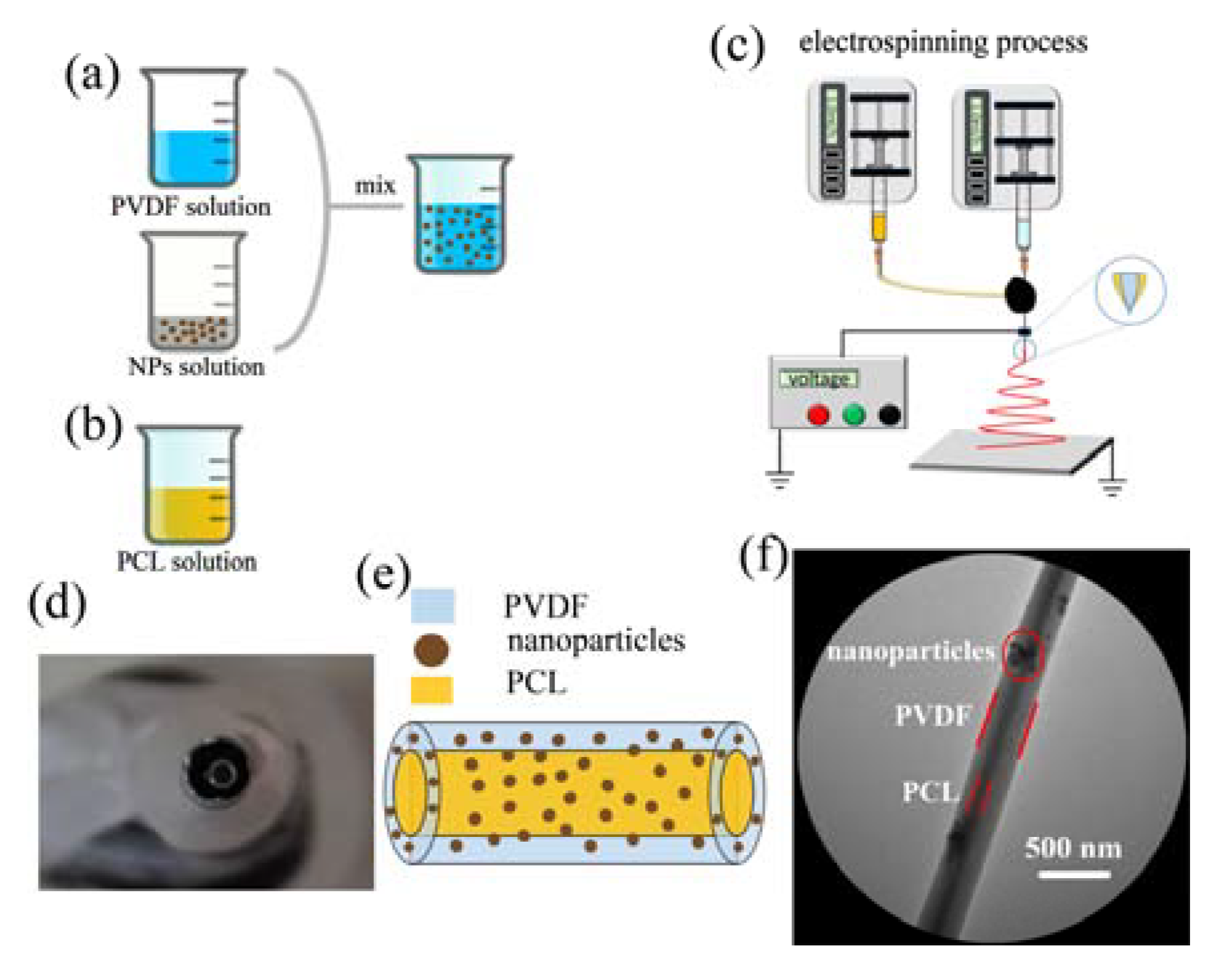
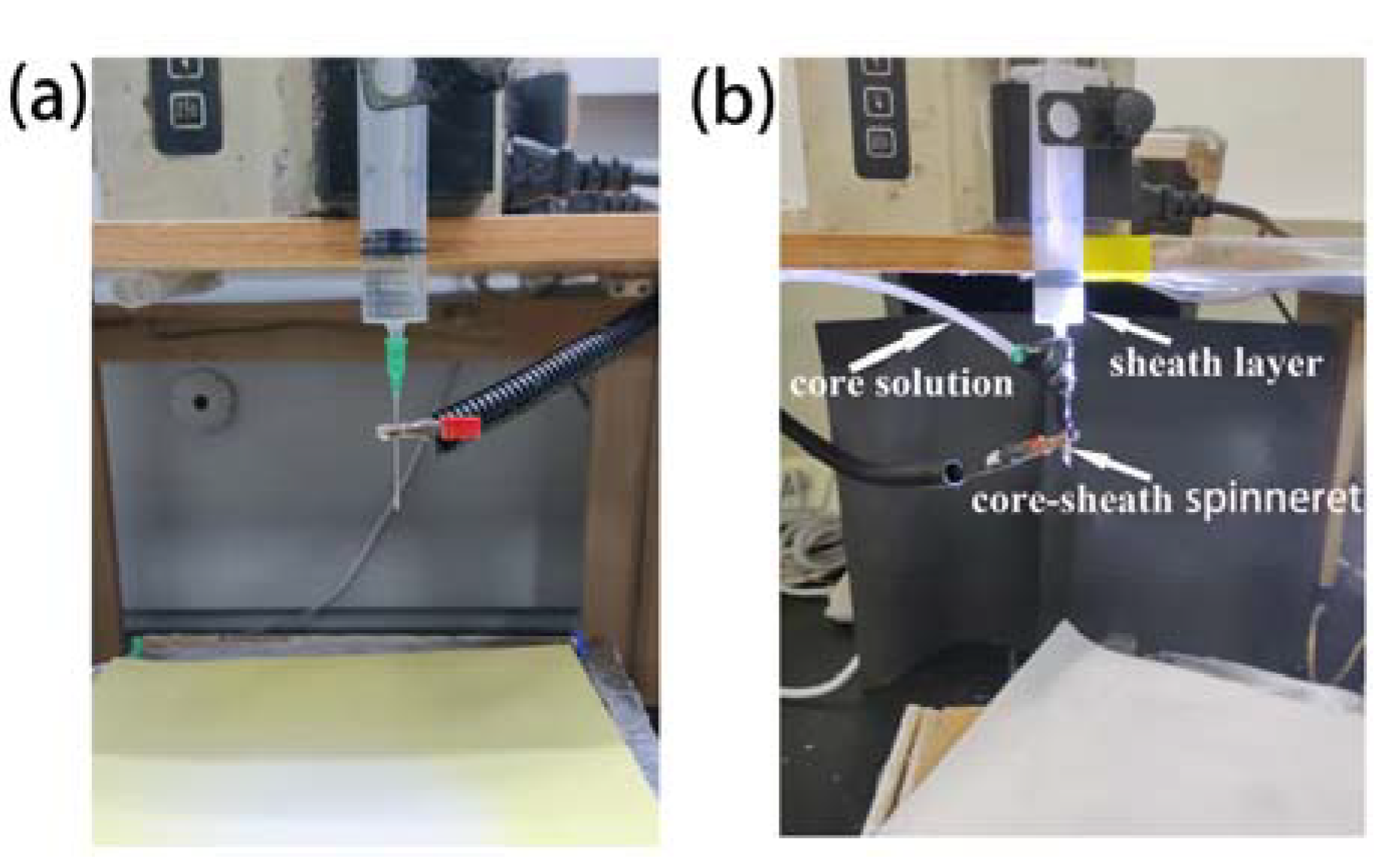
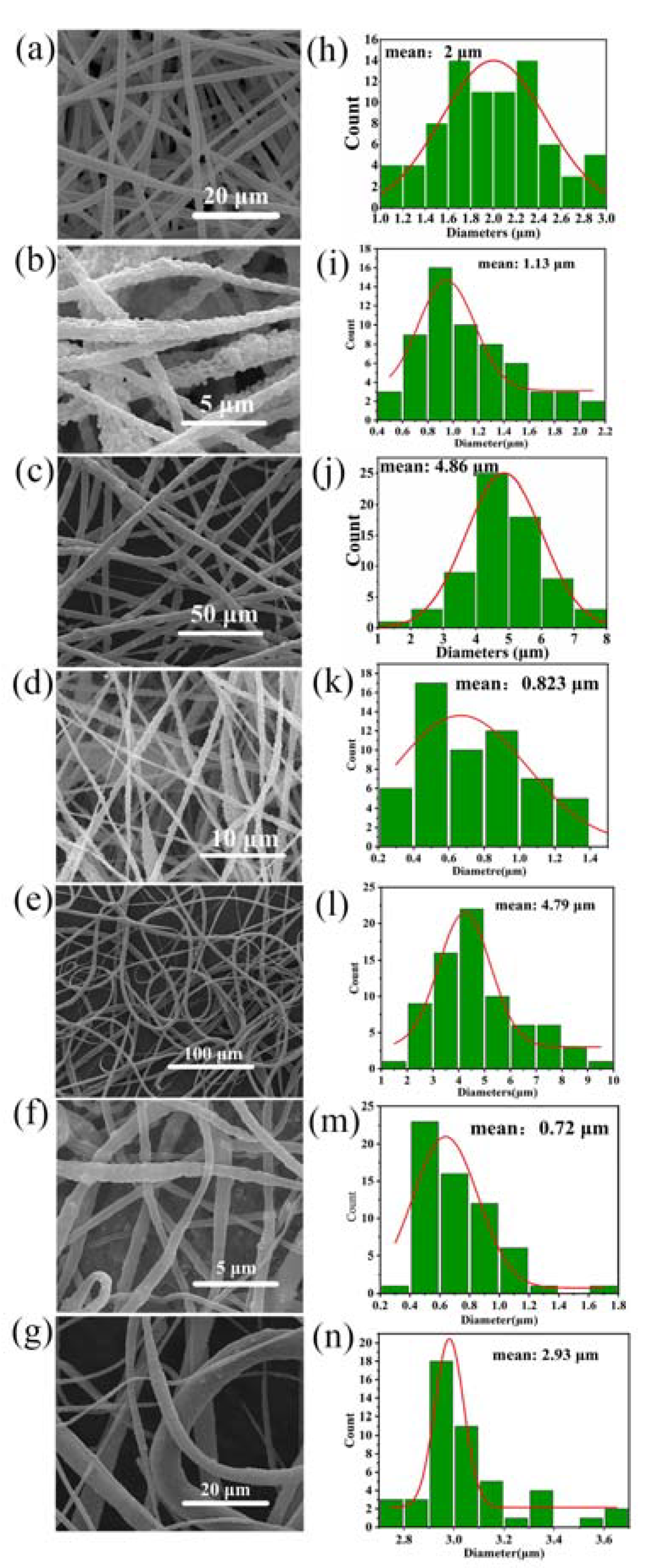
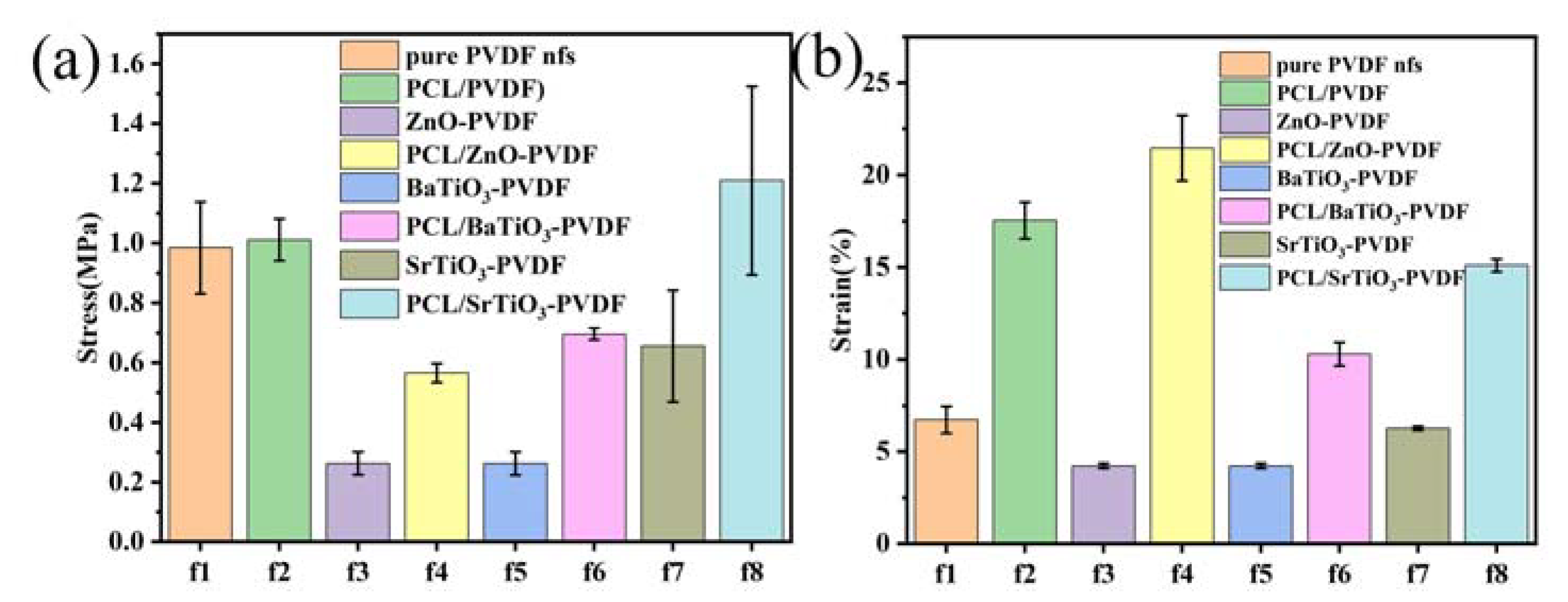
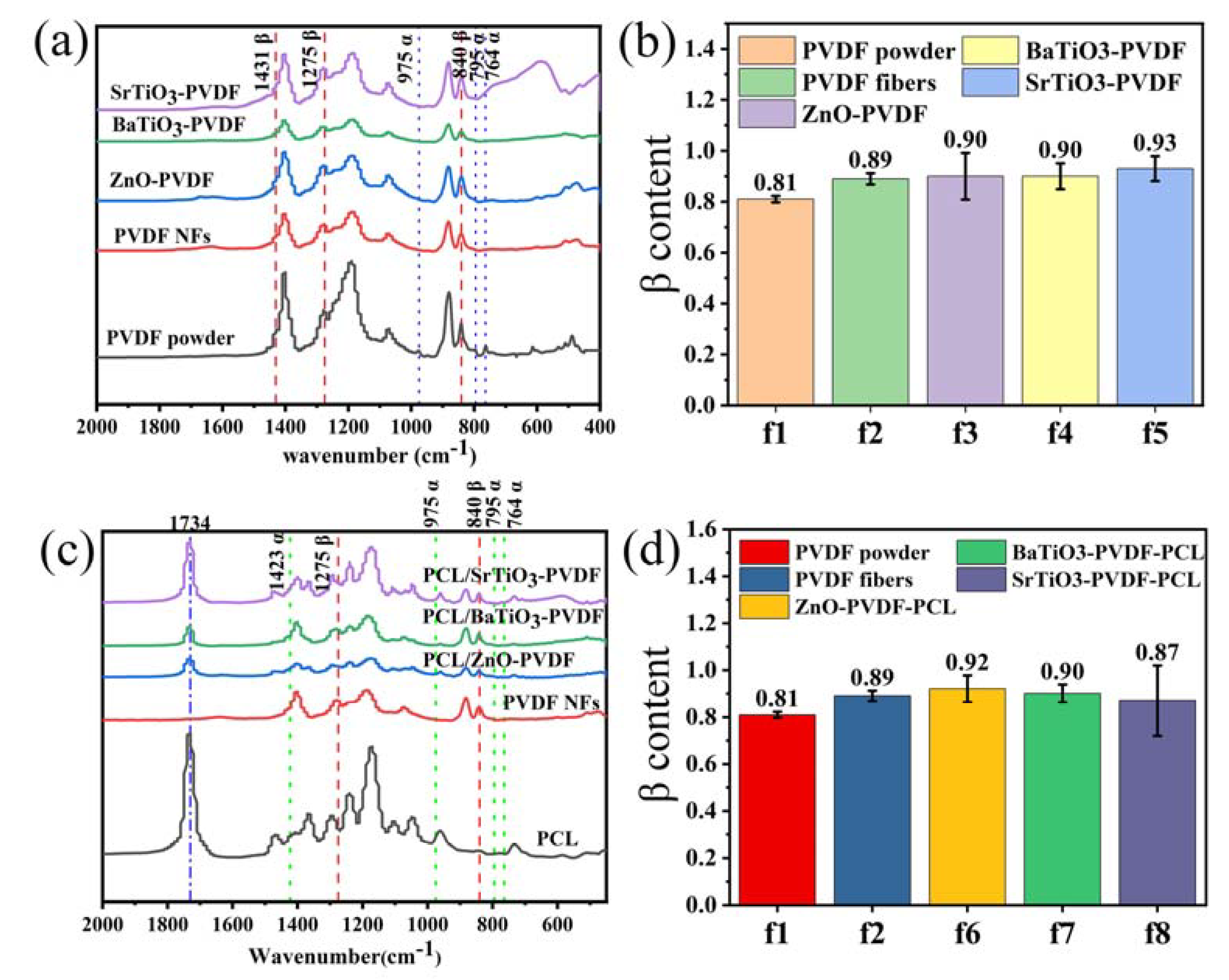
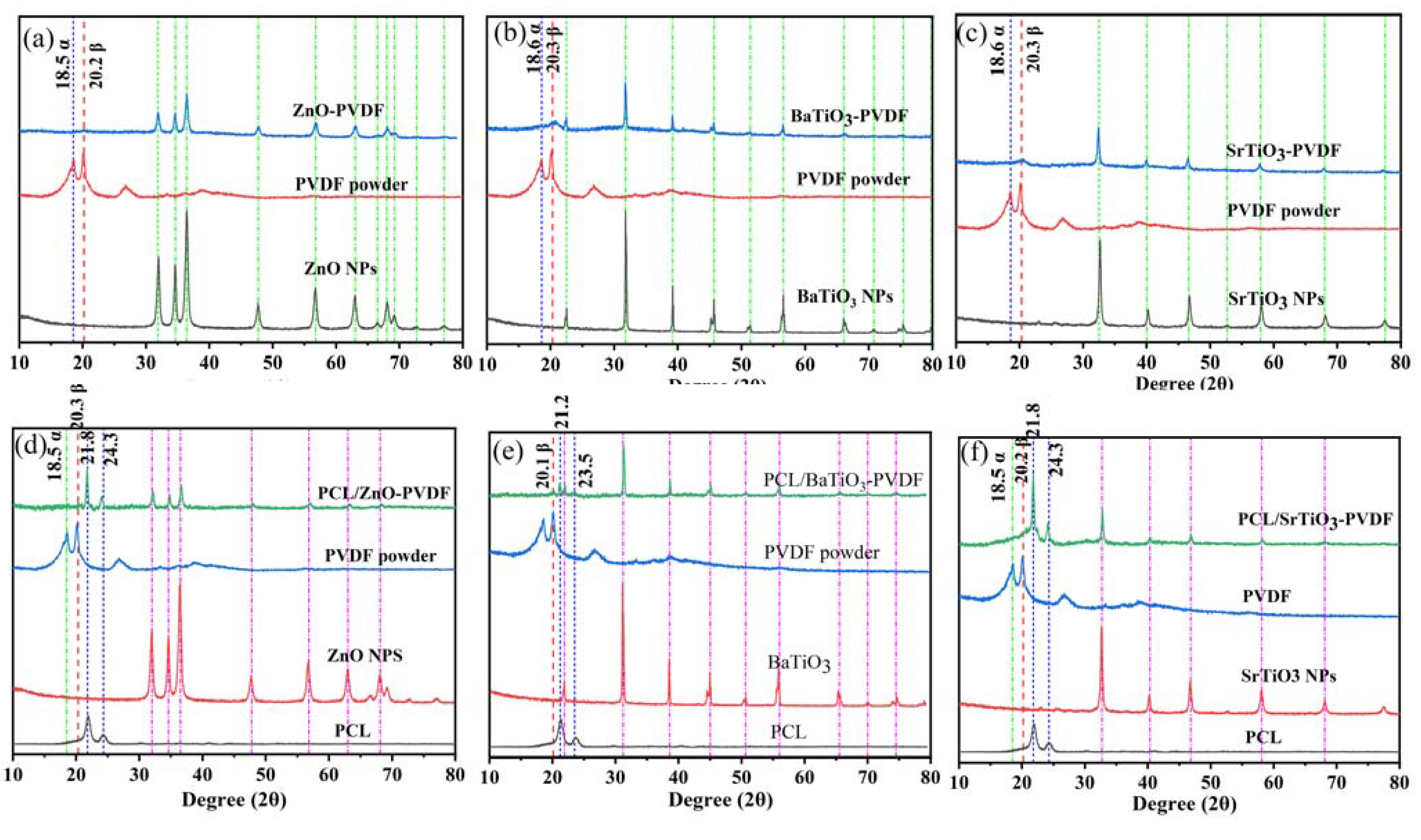
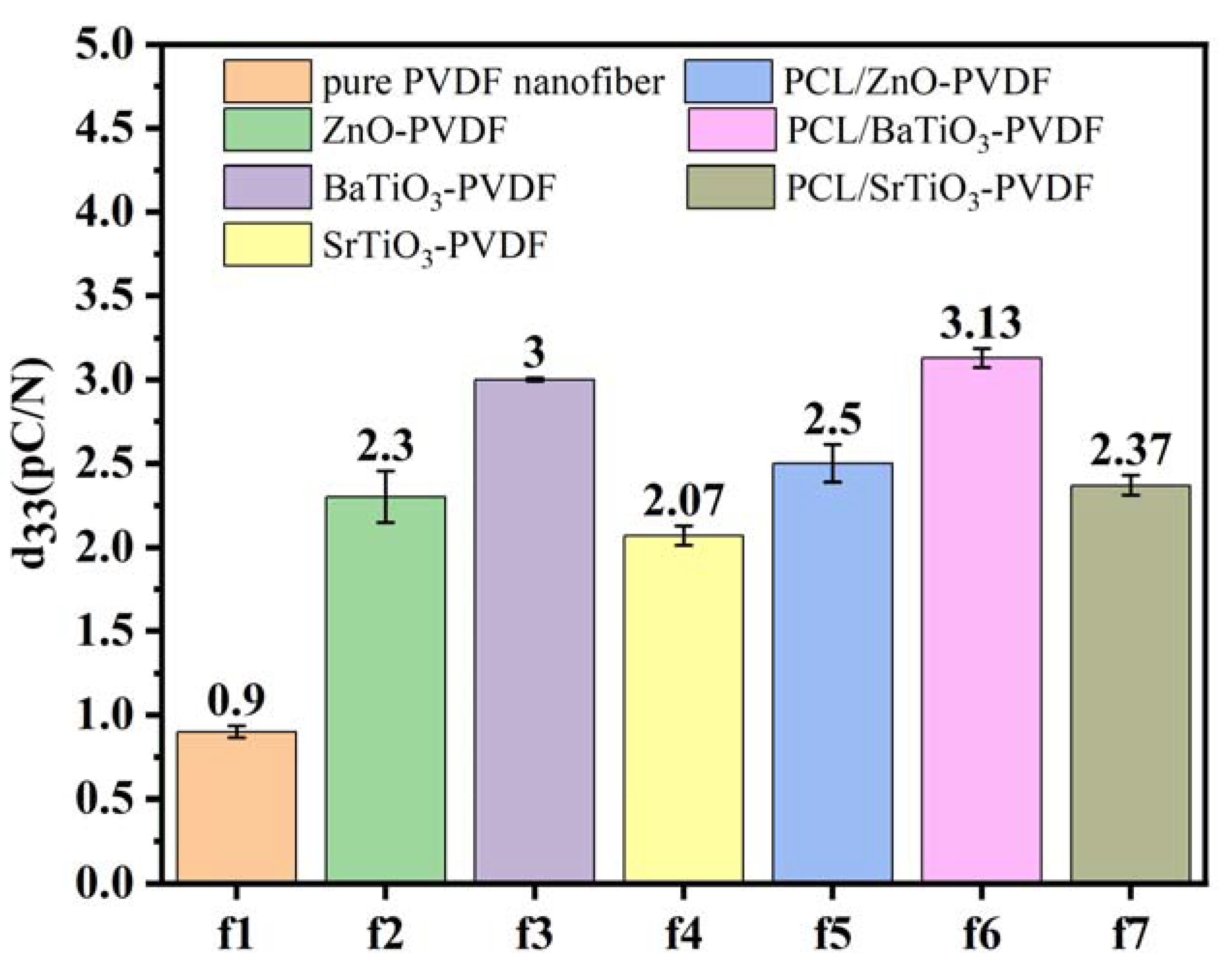
Disclaimer/Publisher’s Note: The statements, opinions and data contained in all publications are solely those of the individual author(s) and contributor(s) and not of MDPI and/or the editor(s). MDPI and/or the editor(s) disclaim responsibility for any injury to people or property resulting from any ideas, methods, instructions or products referred to in the content. |
© 2023 by the authors. Licensee MDPI, Basel, Switzerland. This article is an open access article distributed under the terms and conditions of the Creative Commons Attribution (CC BY) license (https://creativecommons.org/licenses/by/4.0/).
Share and Cite
Feng, Z.; Wang, K.; Liu, Y.; Han, B.; Yu, D.-G. Piezoelectric Enhancement of Piezoceramic Nanoparticle-Doped PVDF/PCL Core-Sheath Fibers. Nanomaterials 2023, 13, 1243. https://doi.org/10.3390/nano13071243
Feng Z, Wang K, Liu Y, Han B, Yu D-G. Piezoelectric Enhancement of Piezoceramic Nanoparticle-Doped PVDF/PCL Core-Sheath Fibers. Nanomaterials. 2023; 13(7):1243. https://doi.org/10.3390/nano13071243
Chicago/Turabian StyleFeng, Zhangbin, Ke Wang, Yukang Liu, Biao Han, and Deng-Guang Yu. 2023. "Piezoelectric Enhancement of Piezoceramic Nanoparticle-Doped PVDF/PCL Core-Sheath Fibers" Nanomaterials 13, no. 7: 1243. https://doi.org/10.3390/nano13071243
APA StyleFeng, Z., Wang, K., Liu, Y., Han, B., & Yu, D.-G. (2023). Piezoelectric Enhancement of Piezoceramic Nanoparticle-Doped PVDF/PCL Core-Sheath Fibers. Nanomaterials, 13(7), 1243. https://doi.org/10.3390/nano13071243






